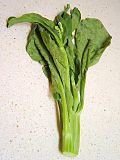Brassica oleracea
Brassica oleracea, or wild cabbage, is a species of Brassica native to coastal southern and western Europe.
| Brassica oleracea | |
|---|---|

| |
| Wild Cabbage plants | |
| Scientific classification | |
| Kingdom: | |
| (unranked): | |
| (unranked): | |
| (unranked): | |
| Order: | |
| Family: | |
| Genus: | |
| Species: | B. oleracea
|
| Binomial name | |
| Brassica oleracea | |
Its tolerance of salt and lime, and its dislike of competition from other plants, restrict it to limestone sea cliffs, like the chalk cliffs on both sides of the English Channel.
Cultivation
B. oleracea is believed to have been cultivated for several thousand years. It has been bred into a wide range of cultivars, including cabbage, broccoli, cauliflower, and more. Some of which are hardly recognisable as being members of the same genus, let alone species.[1]

The plant is used because of its large food reserves, which are stored over the winter in its leaves. It is rich in essential nutrients including vitamin C.
The cultivars of B. oleracea are grouped into seven major cultivar groups, of which the Acephala Group remains most like the natural wild cabbage in appearance:
- Acephala Group: kale and collard greens
- Alboglabra Group: Chinese broccoli
- Botrytis Group: cauliflower, Romanesco broccoli and broccoflower
- Capitata Group: cabbage
- Gemmifera Group: brussels sprouts
- Gongylodes Group: kohlrabi
- Italica Group: broccoli
All are in the same species. However, artificial selection has brought about genetic differences between the groups.[2]
In places such as the Channel Islands and Canary Islands where the frost is minimal, and plants can grow all year round, some cultivars can grow up to 3 meters tall. These "tree cabbages" yield fresh leaves throughout the year, and the plant is not destroyed as with a normal cabbage. Their woody stalks are sometimes dried and made into walking sticks.[3]

Some (notably brussels sprouts and broccoli) contain high levels of sinigrin which may help prevent bowel cancer.
Brassica Oleracea Media
A large wild cabbage (B. oleracea var. oleracea) plant that grew near the sea at Mill Bay in East Portlemouth, Devon, England
Couve-galega (ex. Brassica oleracea var. acephala DC.) for the Portuguese caldo verde
References
- ↑ Dixon, G.R. (2007), Vegetable brassicas and related crucifers, Wallingford: CABI, ISBN 9780851993959
- ↑ Daniel Zohary and Maria Hopf 2000. Domestication of plants in the Old World. 3rd ed, Oxford: Oxford University Press. p199
- ↑ Williams, Paul H.; Hill, Curtis B. (June 13, 1986), "Rapid-cycling populations of Brassica" (pdf), Science, New Series, American Association for the Advancement of Science, 232 (4756): 1385–1389, doi:10.1126/science.232.4756.1385, JSTOR 1697720, PMID 17828914, S2CID 25779465







